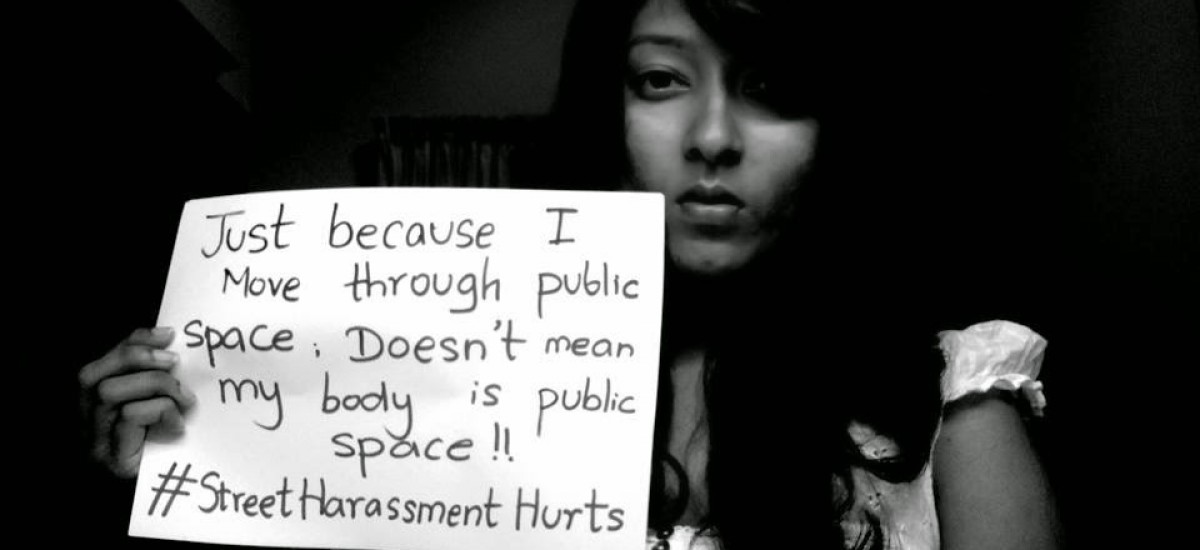Featured image courtesy Streetharassmenthurts
“Virtually unreported, condoned and invisibalised”. These are the words used in Women and Media Collective’s December 2015 Country Profile on Universal Access to Reproductive Rights to describe street-based sexual harassment.
Yet it is a daily reality for most women in Sri Lanka.
The latest published statistics on street harassment date back to 2011.
Deputy Minister of Transport, Rohana Dissanayake alleged in July 2011 that one in four women are subject to sexual harassment in public transport on a daily basis. A survey conducted by the Legal Aid Commission (LAC) in 2011 revealed that 70% of women between the ages of 15 and 45 years have experienced sexual harassment while using public transport. Amarasinghe et al (2004) in a study at Maradana railway station found that as many as 94% of women – from school girls, to working women and girls studying in higher educational institutions – had experienced harassment in public transport.
There have been numerous events conducted to raise awareness against street harassment, and in the social media era, people’s stories are quick to reach a wide audience.
Recently, a father posted a story online about his two young daughters (aged 13 and 17) and a group of drunk beachgoers who passed lewd comments at them, much to his discomfort and anger. What was interesting was one response to this article, by a young man who claimed that ‘boys will be boys’ and suggested that the women secretly felt ‘psychologically validated’ by the attention.
March 8 (Tuesday) marks International Women’s Day, and this year Groundviews decided to highlight the widespread nature of street harassment, by mapping it.
Each marker tells a story – a story of a woman trying to go home, to work, or just about her day – only to be made to feel uncomfortable, or even unsafe.
View the map directly here:
To some, harassment has become normal.
A 2014 Report from the Commission of the Prevention of Violence against Women and the Girl Child noted that harassment was so pervasive, be it on the streets, on public transport or even at the workplace, that women in Sri Lanka often did not question it. This did indeed turn out to be the case for many of the women interviewed, who spoke of ‘the usual catcalls’ as par for the course when traveling to and from work.
The August 2014 incident at the Wariapola bus terminal caused intense debate on the correct response to harassment, and the problems of implementing the law. The girl, who was reacting to sexual harassment, was herself remanded after the boy she slapped was admitted to hospital. She was produced before the JMO and Magistrates Court, and further subject to media scrutiny, with much of the coverage focusing on the girl’s reaction, rather than the issue of sexual harassment. The girl was subjected to ‘double harassment’ since most people seemed to think she had overreacted. As Wijesekara et. Al (2014) pointed out, this tended to reinforce the acceptance of sexual harassment as a ‘normal’ occurrence in Sri Lanka. It was only later that the youth concerned was also remanded, and the girl filed a Fundamental Rights petition against police officers.
Many of the women interviewed by Groundviews did see harassment as normal, talking of ‘the usual catcalls’ when speaking about harassment.
However, others recalled the extreme distress they were in following the incidents they recounted.
“I was extremely upset, I couldn’t help crying as I walked on the road. I felt dirty and used. It was just so disgusting,” one girl speaking to Groundviews said.
“It took me a few days to recover because there wasn’t anyone I could talk to. I was terrified at first…I was new to the country…how do you react to something like this when all your life something like this never happened?”
“I was terrified. Even though now I know there are so many things you could do, your confidence deserts you. The next day I had a fever from the stress and the fear.”
As the Chairperson of the Legal Aid Commission found, women using public transport were often reluctant to make a complaint to the bus conductor, the driver or the police. Further, even bus drivers and conductors were reluctant to give evidence against perpetrators in Court, as long drawn out court proceedings would affect their daily income.
The Penal Code does however make sexual harassment a crime.
In 1995, amendments to the Penal Code replaced Sec.354 relating to assaulting and outraging the modesty of a woman with the new offence of sexual harassment, defined thus:
Unwelcome sexual advances by words or action used by a person in authority, in a working place or any other place shall constitute the offence of sexual harassment.
Whomsoever by assault or by the use of criminal force sexually harasses another person or by the use of words or actions causes sexual annoyance or harassment commits the offence of sexual harassment.
Countless campaigns have also asked women to report incidents to police. In 2014, Stop Street harassment reported a new initiative by the Women and Children’s Bureau – an SMS service to complain about harassment at 0716550000.
Those found guilty under the Penal Code face up to 5 years in prison – but as long as harassment is normalized, and as long as stigmatization continues, particularly in public cases such as that of the Wariyapola case, it will continue to be virtually unreported – an invisible issue.

